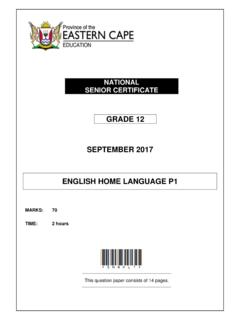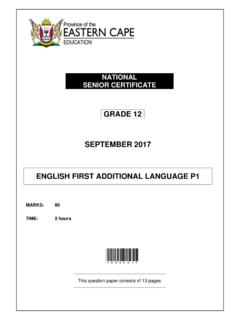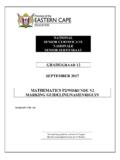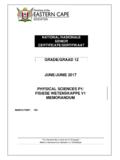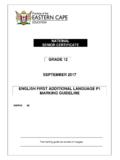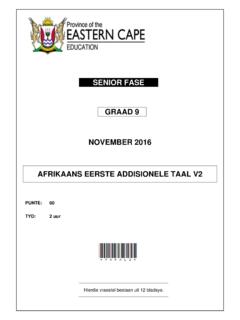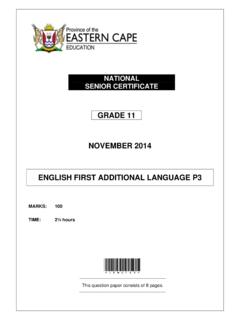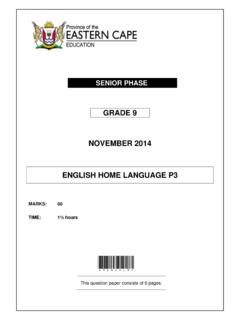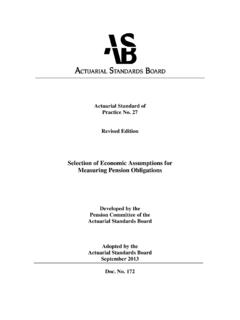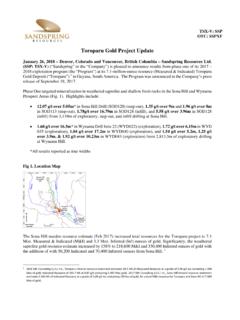Transcription of GRADE 12 SEPTEMBER 2012 ECONOMICS MEMORANDUM …
1 Province of the EASTERN CAPE EDUCATION NATIONAL SENIOR CERTIFICATE GRADE 12 september 2012 economics memorandum MARKS: 300 This MEMORANDUM consists of 19 pages. 2 ECONOMICS ( SEPTEMBER 2012 ) SECTION A QUESTION 1 (LO1 LO4) LO1 C business cycle B public A terms of trade LO2 B demand and supply. C Subsidy A economic profit LO3 C RDP A SDI C free trade. LO4 B benefits debtors. B ecotourists. A CITES (12 x 2) (24) Real flow Managed floating Oligopoly North-South divide Stagflation (5 x 2) (10) C Direct or indirect compulsory payments to the government.
2 H Shows the relationship between tax revenue and tax rate. I Profit maximisation. F An example of a negative externality. A Removal of restrictive laws and regulations. D Incentives to increase sales abroad. E A cause of cost-push inflation. B Resource that can be replenished or replaced. (8 x 2) (16) TOTAL SECTION A: 50 ( SEPTEMBER 2012 ) ECONOMICS 3 SECTION B (Answer any THREE questions from this section.) QUESTION 2 (LO1 AS1 AS4) real Kondratieff Auditor-General decrease (4 x 2) (8) List the THREE types of exchange rate systems Fixed rate Free floating Controlled / managed floating (3 x 2) (6) DATA RESPONSE Refers to a small increase in spending leading to a proportionally larger increase in national income.
3 (2) The higher the mpc, the higher the multiplier will be. Multiplier is directly proportional to mpc. (Any 1 x 2) (2) Multiplier = 1 . 1 mpc = 1 1 0,6 = 1 0,4 = 2,5 Multiplier effect = R1 bn x 2,5 = R2,5 billion (6) DATA RESPONSE Shows the income and expenditure for a three year period.
4 (2) Education (2) Informs the parliament of changes in the economy since the main budget. Indicates the developments in public policy that will shape the next budget. (4) Mr Pravin Gordhan (2) 4 ECONOMICS ( SEPTEMBER 2012 ) Discuss extrapolation as a feature underpinning forecasting. Technique used to predict the future by using past data. It involves the extension of the curve assuming structural variables remain the same. Extending a trend may give information about what is likely to happen.
5 Trend line can be extended for the length of a cycle. Channel lines and resistance points must be considered for the trend of a curve. Predicting economic behaviour using extrapolation is unreliable. (Any 4 x 2) (8) Briefly explain the flows in a circular flow. Flows are economic variables that happen over time. There are two flows: money flow and real flow. Flow of goods and services and factors of production are referred to as the real flow. Income and expenditure are referred to as the money flow.
6 For every real flow there is money flow in opposite direction. (Any 4 x 2) (8) [50] QUESTION 3 (LO2 AS1 AS3) perfect internal artificial independent (4 x 2) (8) List any THREE characteristics of a monopoly. Faced with demand curves Decide on their production levels Are exposed to market forces. No close substitutes. Only one seller. Price makers. Exploit consumers. Protected by barriers of entry. Enjoy favourable circumstances.
7 (Any 3 x 2) (6) DATA RESPONSE To save SA consumers from price fixing (pricing predators). (2) To prevent the abuse of monopoly power. To regulate the market power through mergers and takeovers. To prevent price fixing and collusion. (Any 2 x 2) (4) ( SEPTEMBER 2012 ) ECONOMICS 5 The Competition Commission The Competition Tribunal The Competition Appeal Court (Any 2 x 2) (4) DATA RESPONSE Failure of markets to produce the quantities of goods and services that consumers want at a price that reflect marginal utilities and relative scarcities.
8 (2) Externalities Public goods Merit and demerit goods Imperfect competition Lack of information Advertising Immobility of factors of production Imperfect distribution of income and wealth (Any 3 x 2) (6) Externalities (2) Briefly explain shut-down point in a perfectly competitive market. Profit maximisation is where MR = MC. The firm should consider shutting down when TR<Total cost of production. If TR<TVC, it should consider closing down.
9 If price is below MR/MC, the business will not cover its AVC. If the business is not able to cover AVC, it is better to close down. This point where price is less than AVC is known as closing down point. (Any 4 x 2) (8) Discuss product differentiation as a characteristic of monopolistic competition Products are not identical. Differentiated products are similar in many ways. Similarity means that they can satisfy the same need. Differences are imaginary. May have different brand names but contains the same ingredients.
10 Services of sellers make the product different. Differences in packaging. Packaging of a product makes it different from other products. (Any 4 x 2) (8) [50] 6 ECONOMICS ( SEPTEMBER 2012 ) QUESTION 4 (LO3 AS1 AS4) development IDZ advalorem economic (4 x 2) (8) THREE examples of cash benefits to ensure redistribution of income. Unemployment insurance Disability grant Child support grant Old-age pension (Any 3 x 2) (6) DATA RESPONSE The replacement of goods that was previously imported.
